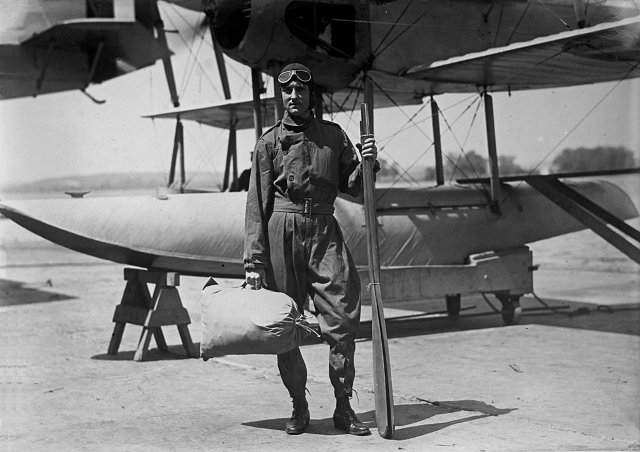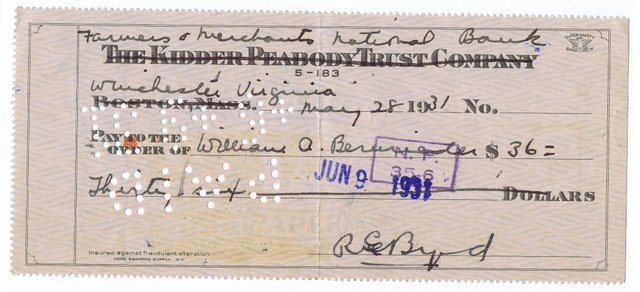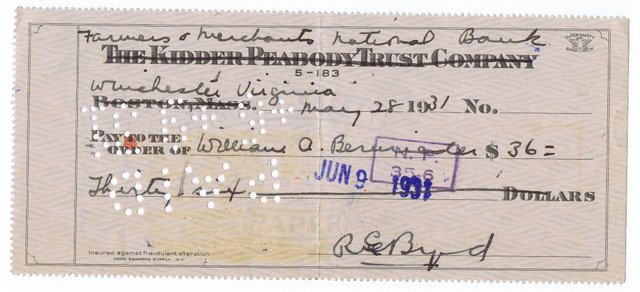Advert Description
Rear Admiral
RICHARD E. BYRD
This is an original/genuine/authentic hand signed cheque by Richard E. Byrd which has been stamped on the front by the FARMERS & MERCHANTS NATIONAL BANK & TRUST COMPANY ? WINCHESTER VA and is over 83 years old.
Dated: 28th May 1931
Check No. -
Payable to ?William A. Bernrieder?
Amount Paid $36.00
This item may be collected or posted
Born:
25th October 1888
Died:
11th March 1957
Rear Admiral Richard Evelyn Byrd, Jr., USN
was an American naval officer who specialized in feats of exploration. He was a pioneering American aviator, polar explorer, and organizer of polar logistics. Aircraft flights, in which he served as a navigator and expedition leader, crossed the Atlantic Ocean, a segment of the Arctic Ocean, and a segment of the Antarctic Plateau. Byrd claimed that his expeditions had been the first to reach the North Pole and the South Pole by air. However, majority of polar experts are now of the opinion that Roald Amundsen has the first verifiable claim to each pole. Byrd was a recipient of the Medal of Honor, the highest honor for heroism given by the United States.
On 9 May 1926, Byrd and pilot Floyd Bennett attempted a flight over the North Pole in a Fokker F-VII Tri-motor monoplane named Josephine Ford, after the daughter of Ford Motor Company president Edsel Ford, who helped finance the expedition. This flight went from Spitsbergen (Svalbard) and back to its take-off airfield. The distance covered was 1,360 miles in 15 and a half hours. Byrd claimed to have reached the Pole. This trip earned Byrd widespread acclaim, including being awarded the Medal of Honor and enabled him to secure funding for subsequent attempts to fly over the South Pole.
From 1926 until 1996, there were doubts, defenses, and heated controversy about whether or not Byrd actually reached the North Pole. In 1958 Norwegian-American aviator and explorer Bernt Balchen cast doubt on Byrd's claim on the basis of his extensive personal knowledge of the airplane's speed. In 1971 Balchen speculated that Byrd had simply circled aimlessly while out of sight of land. However, Floyd Bennett, the pilot on the trip never contested that they didn't reach the pole while he was still alive. (Bennett died on April 25, 1928 during a heroic flight to rescue downed aviators in Greenland.) Bennett would not have been able to dispute the claim, however, as there were no discernible landmarks in the polar region and Byrd had made all the navigational calculations. Simply put, the barren vicinity that the Josephine Ford reached was considered at the time, the geographical North Pole, rather than the pinpoint North Pole.
The 1996 release of Byrd's diary of the 9 May 1926 flight revealed erased (but still legible) sextant sights that sharply differ with Byrd's later 22 June typewritten official report to the National Geographic Society. Byrd took a sextant reading of the Sun at 7:07:10 GCT. His erased diary record shows the apparent (observed) solar altitude to have been 19°25'30", while his later official typescript reports the same 7:07:10 apparent solar altitude to have been 18°18'18". On the basis of this and other data in the diary, Dennis Rawlins concluded that Byrd steered accurately, and flew about 80% of the distance to the Pole before turning back because of an engine oil leak, but later falsified his official report to support his claim of reaching the pole. Others disagree with Rawlins. In 1998, Colonel William Molett, an experienced navigator published "Due north?". Molett maintained that Rawlins had put too much significance in erased navigational calculations which can be explained by any number of other reasons, including favorable windspeeds as well as simple human error due to lack of sleep and stress.
Accepting that the conflicting data in the typed report's flight times indeed require both northward and southward groundspeeds greater than the flight's 85 mph airspeed, a remaining Byrd defender posits a westerly-moving anti-cyclone that tailwind-boosted Byrd's groundspeed on both outward and inward legs, allowing the distance claimed to be covered in the time claimed. (The theory is based on rejecting handwritten sextant data in favor of typewritten alleged dead-reckoning data.) This suggestion has been refuted by Dennis Rawlins
who adds that the sextant data in the long unavailable original official typewritten report are all expressed to 1", a precision not possible on Navy sextants of 1926 and not the precision of the sextant data in Byrd's diary for 1925 or the 1926 flight, which was normal (half or quarter of a minute of arc). Some sources claim that Floyd Bennett and Byrd later revealed, in private conversations, that they did not reach the pole. One source claims that Floyd Bennett later told a fellow pilot that they did not reach the pole. It is also claimed that Byrd confessed his failure to reach the North Pole during a long walk with Dr. Isaiah Bowman in 1930.
If Byrd and Bennett did not reach the North Pole, it is extremely likely that the first flight over the Pole occurred a few days later, on May 12, 1926 with the flight of the airship Norge and its crew of Roald Amundsen, Umberto Nobile, Oscar Wisting, and others. This flight went from Spitsbergen (Svalbard) to Alaska nonstop, so there is little doubt that they went over the North Pole. Amundsen and Wisting had both been members of the first expedition to the South Pole, December 1911. Later, in 1952, the first human being to actually set foot on the North Pole ice was Joseph O. Fletcher, after he landed his aircraft and made a short excursion.
When he returned to the United States from the Arctic, Byrd became a national hero. Congress passed a special action on December 21, 1926 promoting him to the rank of commander and awarding him and Floyd Bennett the Medal of Honor. Byrd and Bennett were presented with Tiffany Cross versions of the Medal of Honor on March 5, 1927 at the White House by President Calvin Coolidge.
As an assistant to Houston mayor Oscar Holcombe, William A. Bernrieder spearheaded a successful local drive to have a Navy heavy cruiser named for the City of Houston. He supported the USS Houston (CA-30) during her years of service as a member of the Cruiser Houston Committee, and following the ship's sinking, continued to memorialize the ship and interact with surviving crew members. This collection consists primarily of materials related to the campaign to have a ship named for the city of Houston, and the history of the USS Houston (CA-30). Additional materials are related to the 1936 visit to Houston of President Franklin D. Roosevelt.
From 1930 to 1933 Bernrieder served as the assistant to Rear Admiral Richard E. Byrd. As part of his duties, he accompanied Byrd on a nationwide speaking tour. During this period, however, Bernrieder paid careful attention to the Cruiser Houston and continued to be involved in supporting the vessel.
Bernrieder was also involved in politics, serving as Executive Secretary for local arrangements for the National Democratic Convention, held in Houston in 1928. He was also involved in arrangements for President Franklin Roosevelt's trip to Houston in 1936.
Receiving his commission in 1926, Bernrieder served for 22 years in the Naval Reserve. He spent five years on active duty with the Navy during World War II, serving on the staffs of five admirals.
Following World War II Bernrieder was involved in the real estate business in Houston, although he continued his interest in the history of the USS Houston (CA-30), which had been lost in the Battle of Sunda Strait on Feb. 28/March 1, 1942. Bernrieder collected information related to the history of the ship as well as efforts to retrieve items from the sunken vessel.




